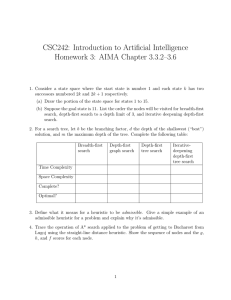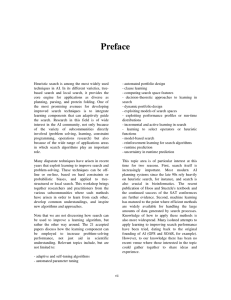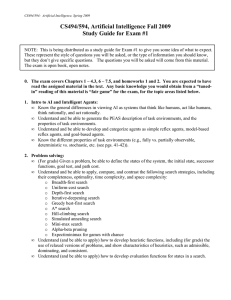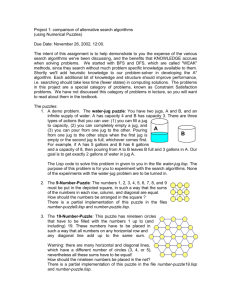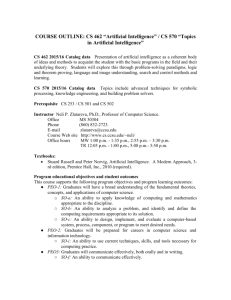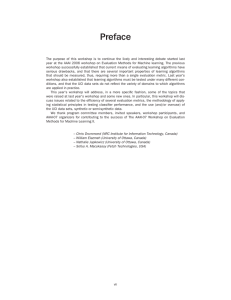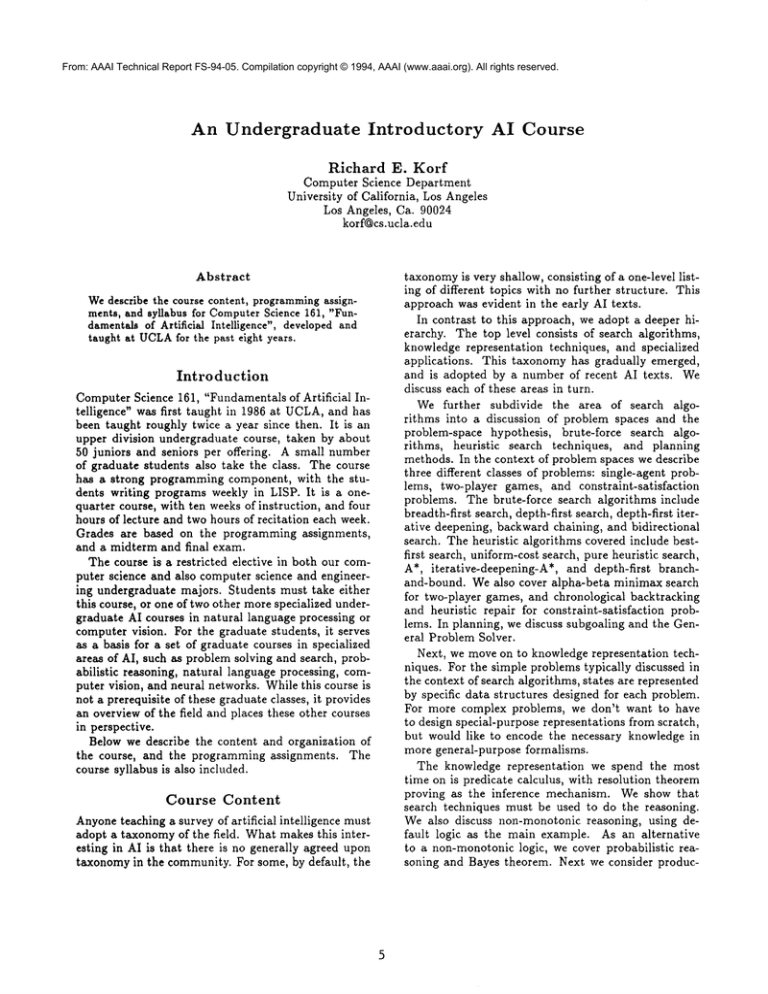
From: AAAI Technical Report FS-94-05. Compilation copyright © 1994, AAAI (www.aaai.org). All rights reserved.
An Undergraduate
Introductory
AI Course
Richard E. Korf
Computer Science Department
University of California, Los Angeles
Los Angeles, Ca. 90024
korf~cs.ucla.edu
Abstract
Wedescribe the course content, programmingassignments, and syllabus for ComputerScience 161, "Fundamentals of Artificial Intelligence", developedand
taught at UCLA
for the past eight years.
Introduction
ComputerScience 161, "Fundamentals of Artificial Intelligence" was first taught in 1986 at UCLA,and has
been taught roughly twice a year since then. It is an
upper division undergraduate course, taken by about
50 juniors and seniors per offering. A small number
of graduate students also take the class. The course
has a strong programming component, with the students writing programs weekly in LISP. It is a onequarter course, with ten weeksof instruction, and four
hours of lecture and two hours of recitation each week.
Grades are based on the programming assignments,
and a midterm and final exam.
The course is a restricted elective in both our computer science and also computer science and engineering undergraduate majors. Students must take either
this course, or one of two other more specialized undergraduate AI courses in natural language processing or
computer vision. For the graduate students, it serves
as a basis for a set of graduate courses in specialized
areas of AI, such as problem solving and search, probabilistic reasoning, natural language processing, computer vision, and neural networks. While this course is
not a prerequisite of these graduate classes, it provides
an overview of the field and places these other courses
in perspective.
Below we describe the content and organization of
the course, and the programming assignments. The
course syllabus is also included.
Course Content
Anyoneteaching a survey of artificial intelligence must
adopt a taxonomyof the field. What makes this interesting in AI is that there is no generally agreed upon
taxonomyin the community. For some, by default, the
taxonomyis very shallow, consisting of a one-level listing of different topics with no further structure. This
approach was evident in the early AI texts.
In contrast to this approach, we adopt a deeper hierarchy. The top level consists of search algorithms,
knowledge representation techniques, and specialized
applications.
This taxonomy has gradually emerged,
and is adopted by a number of recent AI texts. We
discuss each of these areas in turn.
We further subdivide the area of search algorithms into a discussion of problem spaces and the
problem-space hypothesis, brute-force search algorithms, heuristic search techniques, and planning
methods. In the context of problem spaces we describe
three different classes of problems: single-agent problems, two-player games, and constraint-satisfaction
problems. The brute-force search algorithms include
breadth-first search, depth-first search, depth-first iterative deepening, backward chaining, and bidirectional
search. The heuristic algorithms covered include bestfirst search, uniform-cost search, pure heuristic search,
A*, iterative-deepening-A*,
and depth-first branchand-bound. Wealso cover alpha-beta minimax search
for two-player games, and chronological backtracking
and heuristic repair for constraint-satisfaction
problems. In planning, we discuss subgoaling and the General Problem Solver.
Next, we move on to knowledge representation techniques. For the simple problems typically discussed in
the context of search algorithms, states are represented
by specific data structures designed for each problem.
For more complex problems, we don’t want to have
to design special-purpose representations from scratch,
but would like to encode the necessary knowledge in
more general-purpose formalisms.
The knowledge representation
we spend the most
time on is predicate calculus, with resolution theorem
proving as the inference mechanism. We show that
search techniques must be used to do the reasoning.
Wealso discuss non-monotonic reasoning, using default logic as the main example. As an alternative
to a non-monotonic logic, we cover probabilistic reasoning and Bayes theorem. Next we consider produc-
tion systems as a representation of knowledge, and finally structured representations such as semantic nets,
frames, and scripts.
The last high-level group of topics in the class are
the specialized applications of AI. These include expert
systems, natural language processing, speech understanding, computer vision, and robotics. To some extent the presentation of the knowledge-representation
techniques overlap with the treatment of the applications. For example, expert systems are discussed along
with production systems, and semantic nets, frames,
and scripts are treated in the context of naturallanguage understanding.
For completeness, we also briefly discuss neural nets
as an alternative to the symbolic processing paradigm.
Programming
Assignments
Programmingin LISP is a large part of the course, and
indeed the activity that the students spend most of
their time on. The rationale is that real understanding
of algorithms and data structures or representations
comes from programming them. In practice, a course
in LISP is a prerequisite to this course.
There are weekly programming assignments, which
the students are required to write in pure applicative
LISP. The reason for this latter requirement has less to
do with AI than with general computer science considerations. This course requires students to program recursively rather than iteratively, a style they are much
less familiar with.
The first assignment asks the student to give different implementations of the Fibonacci function, including both exponential and linear-time versions, and to
analyze their complexity. The main point of this assignment is to drive home the point of combinatorial
explosion. They realize that even computing the 50th
Fibonacci number could takes days using the naive
algorithm, and that the 100th would take billions of
years.
The next assignment is to implement several different brute-force search algorithms, including breadthfirst, depth-first and depth-first iterative deepening.
The inputs to these functions are explicit trees represented as LISP lists, and the output is a list of the
atoms in the tree in the order they would be visited by
each algorithm.
The students then implement the A* algorithm, using a problem such as the Five Puzzle, a two by three
variant of the familiar Eight Puzzle. The smaller puzzle requires less memoryfor the open list, and allows
an inefficient implementation in interpreted LISP to
run in a reasonable amount of time.
Next the students implement minimax search with
alpha-beta pruning. To eliminate the overhead of implementing a real two-player game, the input to their
function is a tree represented as a list, with the atoms
being the numeric static evaluations of the associated
frontier nodes.
The N-queens problem is then solved using chronological backtracking, with each solution represented as
an N-element list giving the column positions of the
queens in each row.
Another assignment concerns using the ideas of the
General Problem Solver to solve the Towers of Hanoi
Problem. What makes this problem more interesting
than the standard solution is that the student’s program must find an optimal solution for any pair of legal
initial and goal states.
The next assignment is a resolution theorem prover
for propositional logic. A related assignmentis to write
a program to transform an expression in propositional
logic into clause form. The solution to this problem
typically involves a separate function for each step of
the transformation, and most of the code of each of
these functions performs pattern matching.
Wethen ask the students to implement a simple production system. As an application of the production
system we ask them to write productions to transform
propositional logic expressions into clause form. This
solution to the problem is much simpler than their
first brute-force approach to the problem, with all the
pattern-matching code collected together in the interpreter, and each transformation expressed by a simple
production that is easier to read and understand. Another application of the production system is to do
parsing of simple natural language sentences, with the
production rules representing the grammar.
Syllabus
The following is the syllabus for the last offering of
CS161 in the Spring of 1994. Each item represents
approximately one two-hour lecture.
1. Introduction to course and artificial
intelligence,
LISP expressions, functions, conditionals.
2. Recursion, LET,list primitives, recursive list functions.
3. Problem spaces, problem types, search trees and
graphs, AND/ORtrees.
4. Brute-force search, breadth-first, depth-first, depthfirst iterative-deepening.
5. Bidirectional search, heuristic search: best-first,
form cost, pure heuristic search, A*,
6. Iterative-deepening-A*,
branch-and-bound.
7. Two-player games, minimax search,
pruning.
8. Constraint-satisfaction
heuristic repair.
uni-
Depth-first
alpha-beta
problems, backtracking and
9. Planning, subgoaling, General Problem Solver.
10. Midterm exam.
11. Propositional and predicate calculus.
12. Resolution in propositional logic, conversion to
clause form.
13. Unification, resolution theorem proving in predicate
calculus, Prolog.
14. Non-monotonicreasoning, default logic, decidability,
multiple extensions.
15. Probabilistic reasoning, Bayes theorem.
16. Production systems, expert systems.
17. Natural language processing, grammars, syntax and
semantics.
18. Structured representations, semantic nets, frames,
scripts.
19. Perception, speech, vision, line labelling of polyhedral scenes.
20. Neural networks.
Acknowledgements
The preparation of this paper was supported by NSF
Grant No. IRI-9119825, and a grant from Rockwell
International.

